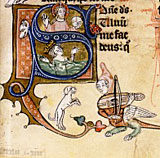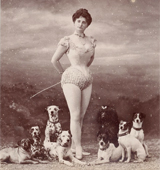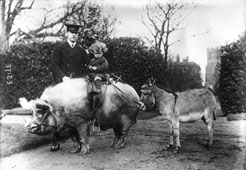by Pascal Jacob
When the first nomadic hunter-gatherer societies transformed into sedentary communities of farmers-breeders, they placed the taming and impregnation of wild animals at the very heart of their development practices. Primitive wolves, horses and cattle will thus gradually be the first source of cleverly nurtured complicities between humans and animals and will give rise to many different breeds of domestic species. This step, which was decisive for the emergence of a society that would soon be able to establish and maintain large herds associated with prosperity and security, was accompanied by an evolution in impregnation and training.
Partners in everyday life
The dog bloodline is genetically different from that of the grey wolf about 100,000 years ago and the oldest confirmed traces of canids date back to 12,000 years before our era. Humans take advantage of this divergence and tame the dog to turn it into an everyday companion and a helper in hunting and fighting. The practice of hunting, which has become a leisure activity, leads to dog training according to needs and prey. Little by little, a vital necessity will turn into a new problem of comfort where dogs and horses in particular, selected for unforeseen learning skills, will acquire a new status with their owners. A further step is taken when these new companions become docile partners and contribute to developing a new hierarchy of forms and disciplines related to the exhibition and entertainment professions. Since the Middle Ages, fairs have been seen as a formidable melting pot of intentions, inventions and knowledge, and animal handlers have found a captive audience always ready to marvel at the spectacle of a calculating goat or raven, a cat orchestra or a rabbit musician.
Creatures of proximity
Swaying between laziness and ease, probably also because animals close to humans have immediate training abilities, street entertainers often prefer dogs and monkeys to exercise their talents. You also choose your partners according to your means and if dogs, goats, squirrels, rabbits, marmots, crows or magpies are popular with saltimbanques, it is mainly because they cost little or nothing to feed. Dogs and goats can also carry small loads and thus relieve their owners' shoulders. One of the main qualities of these companions on good and bad days is endurance: an animal that is not able to walk long distances is not considered suitable as a partner. The addition of a donkey or a horse makes it possible to add to the troupe's resources by stacking cages and baskets on the animal to carry them. The entertainers appreciate being able to renew or develop their companies of skilled animals at little cost, but the circle of their residents is widening with small woodland species that are easy to capture and tame.
If in the 17th century the King of Poland, Jean Sobieski, had a marmot, a fox, a badger and an otter in his gardens, he obviously did not require them to be skilled, but these creatures of "proximity" did meet the needs of animal handlers who were always looking for something new to enrich their work.
The beginnings of training are uncertain, and it is likely that the first presentations were limited to modest exhibitions: the simple ability to hold and keep alive animals collected from the woods or meadows, discreet by nature, is already a feat. These demonstrations are offered to the curiosity of the onlookers with a lot of blathering, but they are still very basic. Gradually enriched, the repertoire of these animals, increasingly considered savant, will form the basis of training in the generic sense.
The proximity of the cat, a source of worship in Egypt, an eminent rodent hunter who gradually became a living room and companion animal in the West, has been a source of inspiration for some trainers working on singular skit scenes where the little feline lends itself to the ambiguous and playful interplay with brave white mice. Donkeys, horses and ponies were not left out and quickly became part of the great register of companions of a human race always concerned with modelling the surrounding natural environment.









